What is Barcelona known for? The Catalan capital is one of the most famous cities in the world, known for its rich architecture, gastronomy, and culture. Indeed, Barcelona is the home of the Sagrada Família, a masterpiece of Catalan modernism architecture and the most famous work of Antoni Gaudí.
There are also world-beating food markets, a storybook old town, and some of the best museums in Spain for travelers to explore. What is Barcelona famous for? Soccer is a big part of Barcelona’s personality, too, with F.C. Barcelona, the city’s beloved soccer club, one of the most successful in the world.
From its miles of golden beaches to the whimsical Park Güell, and more of Gaudí’s famous architecture, here’s everything that this glorious Spanish city is known for.
Las Ramblas
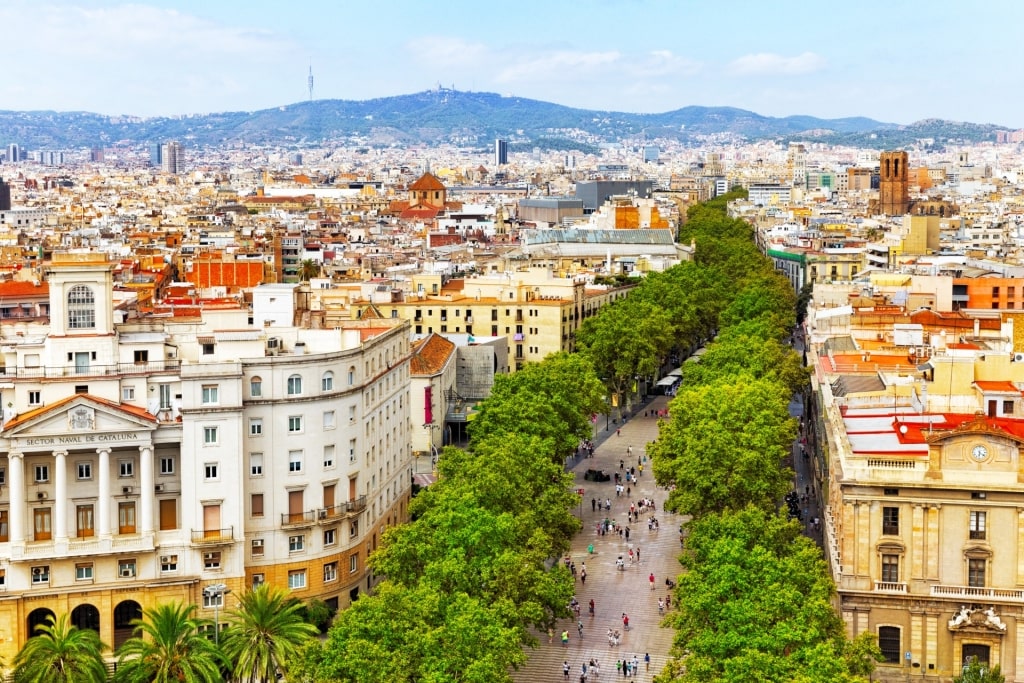
Las Ramblas
Las Ramblas is as famous as New York’s Fifth Avenue and the Champs Elysees to Paris; a thronging strip lined with shops, bars, restaurants, and entertainment. The beating heart of Barcelona, tree-lined Las Ramblas runs from a corner of Plaça de Catalunya to the Columbus Monument near the seafront.
A popular meeting point on Las Ramblas, which is technically five streets linked together, is the Font de Canaletes, a historic fountain near Plaça de Catalunya. Notable buildings include the Liceu Opera House. Founded in 1847, it’s the oldest theater in Barcelona that’s still in use as an actual theater.
There is a carnival-like atmosphere on Las Ramblas, with flower stalls, caricature artists, and street performers adding to the merry ambiance. Browse the many shops, pick up Spanish souvenirs, and savor an ice cream from one of the many vendors.
City Beaches
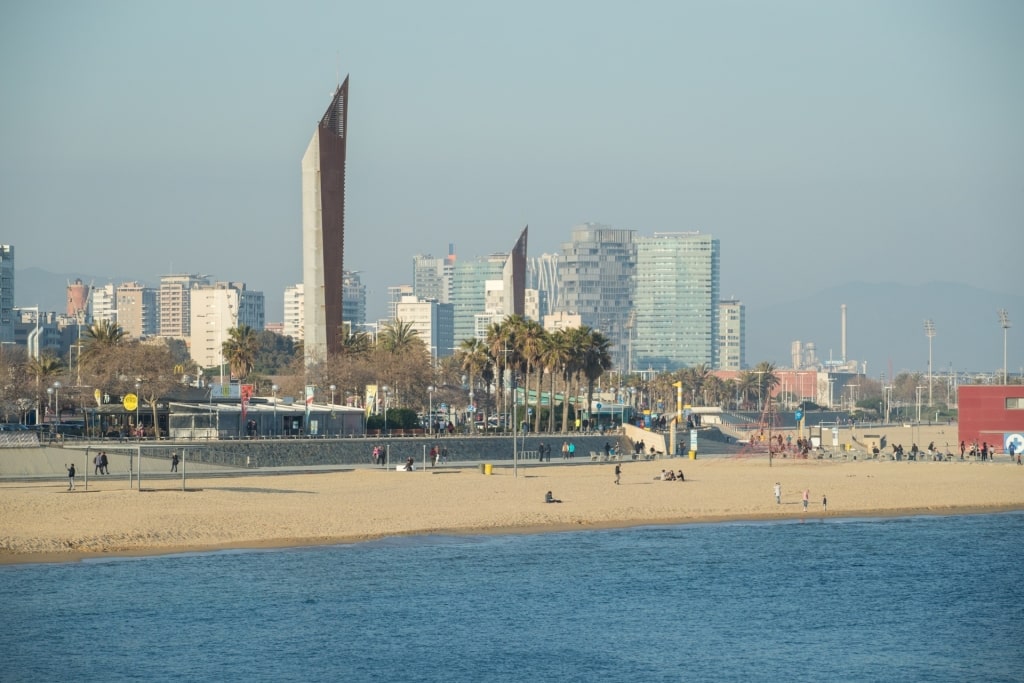
Beach in Barcelona
Strung together like a shimmering pearl necklace, Barcelona’s 28 beaches benefit from the warm glow of the Mediterranean sun, with soft sand and gentle waves unfurling for three miles.
Barcelona’s beaches have excellent facilities, including free WiFi and watersports amenities. One of the most popular beaches in Barcelona is Barceloneta, a vibrant strip that fronts the city’s former seafaring neighborhood, with bars, restaurants, and access to bathrooms.
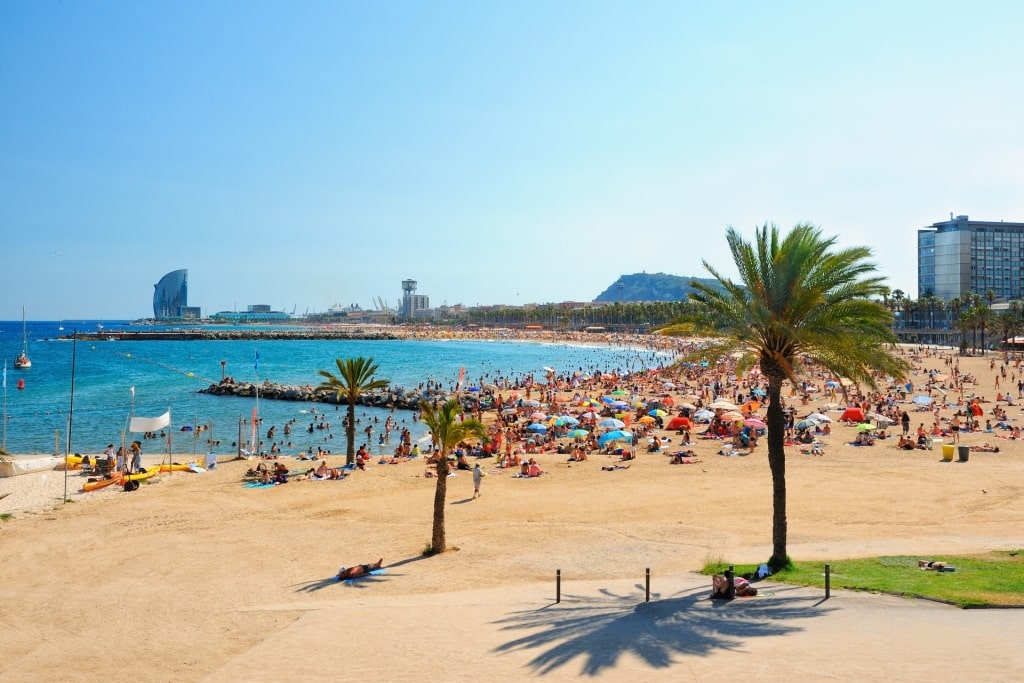
Barceloneta Beach
At the opposite end of Barcelona’s shoreline is Platja de Llevant, a less crowded spot with plenty of space for sunbathing and swimming. Nova Icaria Beach, lying somewhere in the middle, is next to the attractive Port Olímpic and has excellent sailing and watersports facilities.
One of the best things to do in Barcelona is to wander the city’s seafront promenade, Passeig Marítim, stopping at a relaxed seafront restaurant or bar between cooling sea swims and sandy strolls.
Park Güell
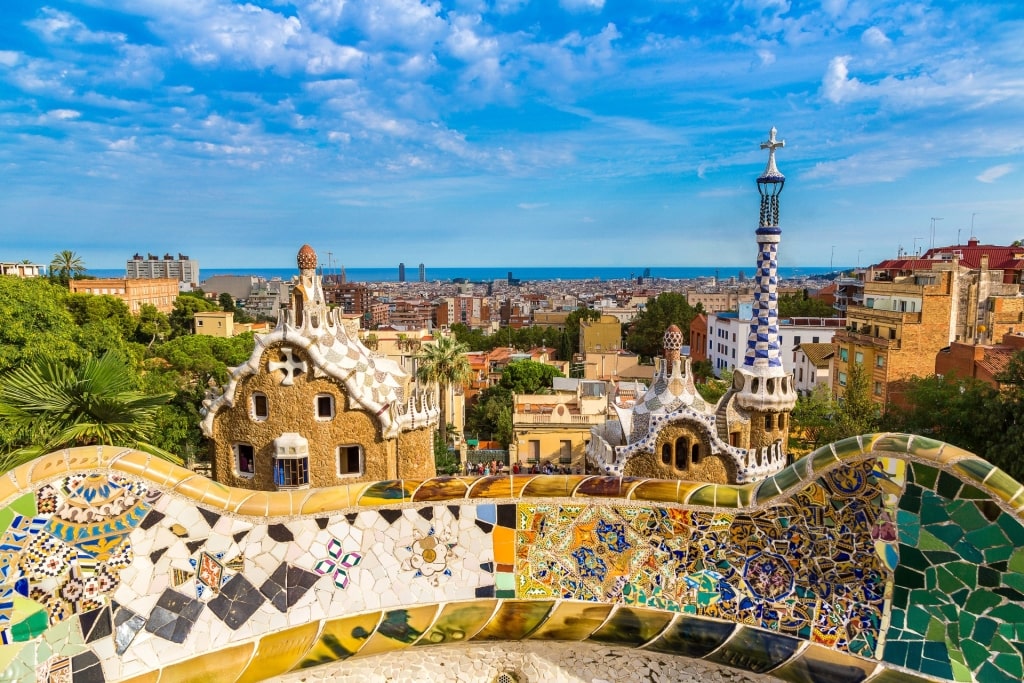
Park Güell
What is Barcelona known for? Scenes of the beautiful mosaic-tiled Park Güell, a fairytale park that sits on a hillside above Barcelona.
Originally intended as an upmarket residential estate, Park Güell was a project between Eusebi Güell, after whom it is named, and Antoni Gaudí, who designed it in the early 20th century. The 42-acre estate was officially opened as a municipal park in 1926 after Güell’s heirs sold it to the city.
There are two fanciful houses within the park. One is the former home of Eusebi Güell, while the other belonged to Gaudí. The famous architect lived here from 1906 until he died in 1926, and it is now the Gaudí House Museum. Though the Spanish museum is temporarily closed for renovations, visitors can admire the pink-hued exterior and soaring spire while exploring this ornate park.

Sala Hipòstila, Park Güell
Sala Hipòstila, a space originally intended to be used as a public market, features 86 Doric-style columns with a sweeping staircase adorned with a dazzling salamander encased in ceramic tiles. Don’t miss the pine-scented Pòrtic de la Bugadera, The Laundry Room Portico, with its wave-like design and leaning columns.
Read: Best Things to Do in Barcelona With Kids
La Boqueria Market
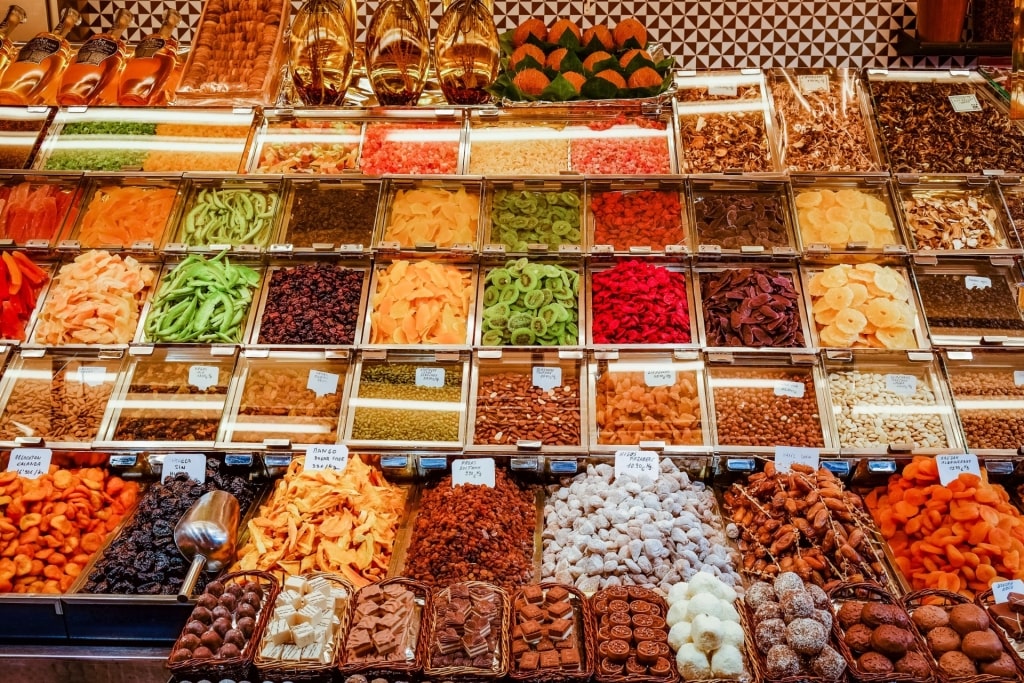
La Boqueria Market
La Boqueria is a world-famous produce market on Las Ramblas, crammed with appetizing stalls, bars, and restaurants serving authentic Spanish food.
Iterations of Boqueria Market have existed since the 12th century, when farmers from around the region would set up stalls to sell their produce. The existing market opened in 1836 and was updated in 1914 when turned into a covered market.
Stalls are lined with cured meats and cheeses, fresh fruit and vegetables. Churros, nuts, olives, and offal are among the items sold. Pick up a fresh fruit smoothie, cones of jamon Iberico, and fried fish.
The fish stalls are often the most fascinating, with stalls piled high with urchins, scallops, and goose barnacles. There are plenty of places to sit down and graze, including Bar Boqueria, where patrons can sip on effervescent Cava, and dine on smoked sardines, padrón peppers, and garlic shrimp.
Architecture

Sagrada Família
Barcelona is chock-full of striking architecture, including Renaissance, Gothic, and Modernist masterpieces. Indeed, the city’s most famous son was Antoni Gaudí, a Catalan architect, whose work includes the flamboyant Sagrada Família.
This UNESCO-listed basilica will be finished in 2026 following a 138-year build and its sky-piercing towers are the city’s star attraction. More of Gaudí’s oeuvre can be seen at Casa Batlló and La Pedrera, also known as Casa Mila, on Passeig de Gràcia. Both are considered some of the most beautiful places in Spain.
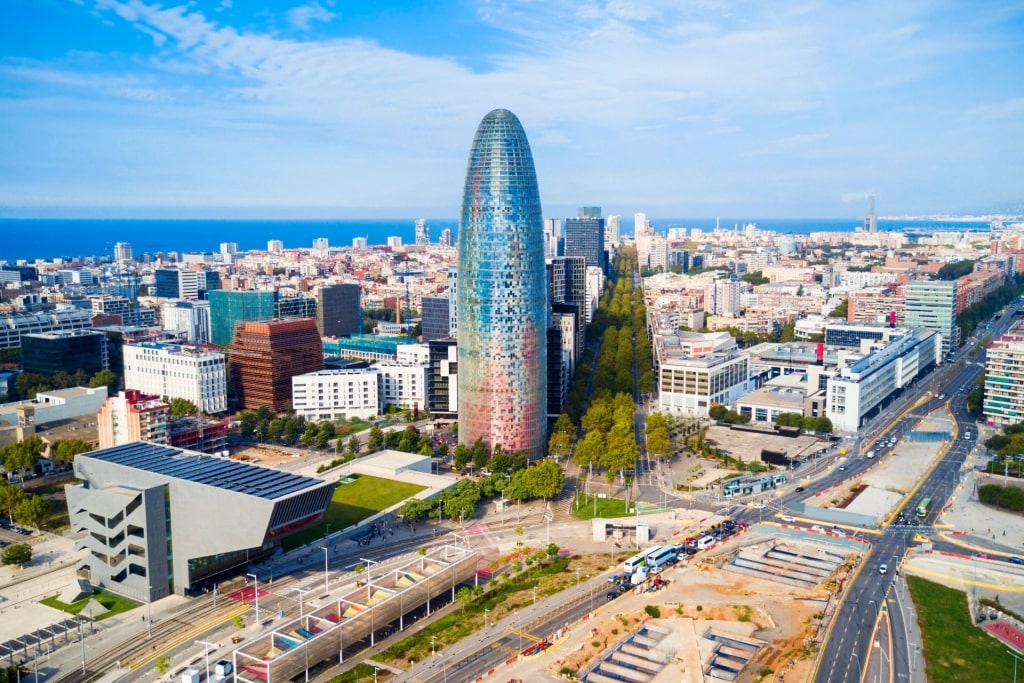
Torre Glòries
Barcelona boasts modern architecture, too, in the shape of the 38-story Torre Glòries building. This cucumber-shaped skyscraper has a 30th-floor observation deck that opens to the public every Tuesday during summertime.
Another of Barcelona’s most significant buildings is Palau de la Música Catalana, designed by architect Lluís Domènech i Montaner. Completed in 1908, the concert hall features an extraordinary gold and blue stained-glass ceiling.
If you have a penchant for Rationalist architecture, you’ll adore Fundacio Joan Miro. Designed by the artist’s close friend, architect Josep Lluis Sert, on Montjuïc Hill, white reinforced concrete walls encase functional spaces designed around courtyards, terraces, and gardens.
The Columbus Monument
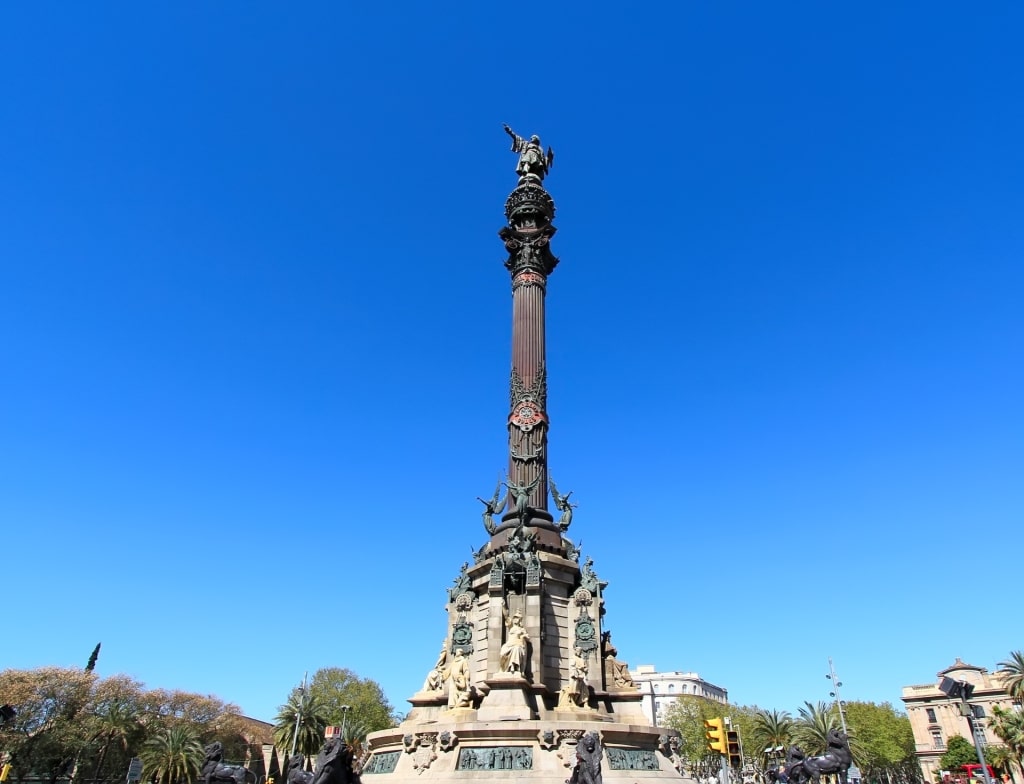
Columbus Monument
Built in 1888, the Columbus Monument is a 197-foot Corinthian column topped with a bronze statue of the 15th-century explorer Christopher Columbus by sculptor Rafael Atché. Situated near the waterfront, the statue shows Columbus pointing toward the sea. It was erected in honor of his first voyage to the Americas in 1492.
More statues decorate the base representing figures associated with Columbus, such as the 15th-century ruler of Spain, Ferdinand II of Aragon, and mariner Martín Alonzo Pinzón, who sailed with Columbus to the Americas.
An elevator inside the statue’s base takes visitors to the top for a birds-eye view of Las Ramblas, Montjuïc Hill, and the Mediterranean Sea.
Museums
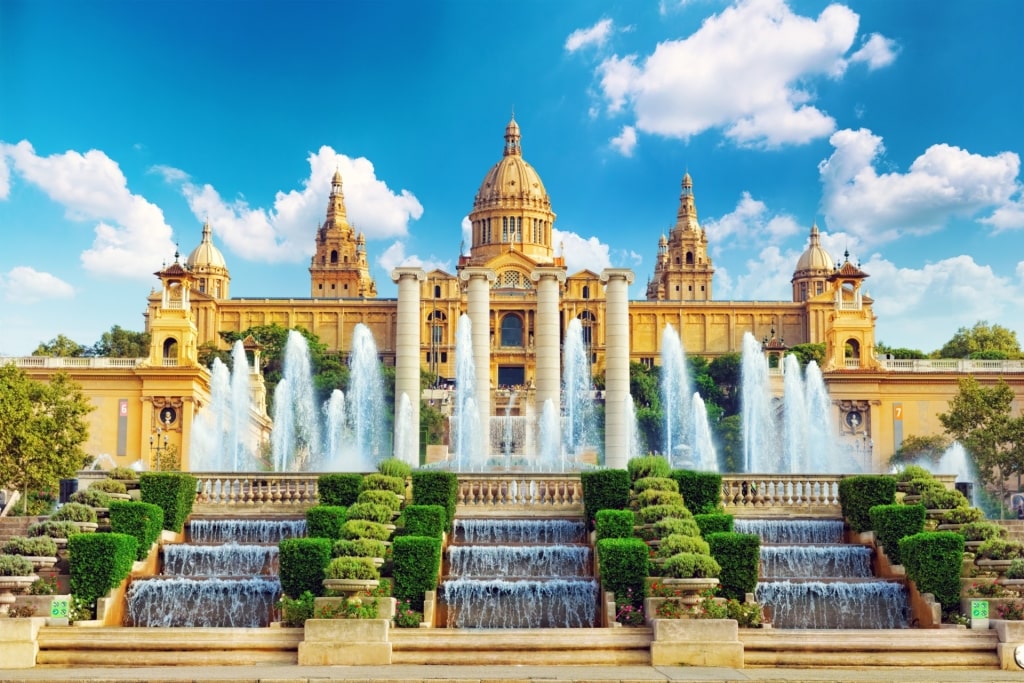
Museu Nacional d’Art de Catalunya
Barcelona is one of the best cities for art in the world, and exploring its top-drawer museums is ideal for culture-thirsty travelers, starting with the Museu Nacional d’Art de Catalunya. Housed in a sprawling palace on Montjuïc Hill, it contains a vast collection of the region’s best art from the 12th to the 20th century, including a remarkable collection of Romanesque paintings and Catalan modern art.
Close by, history lovers will enjoy the Catalan Museum of Archaeology for its permanent collection containing remains from the first prehistoric settlers in the region to items from the medieval period.
Head to Moco Museum in the El Born neighborhood of Barcelona to view eclectic modern and contemporary art. Next door, the Picasso Museum is home to 4,251 works by the celebrated 20th-century Spanish artist.
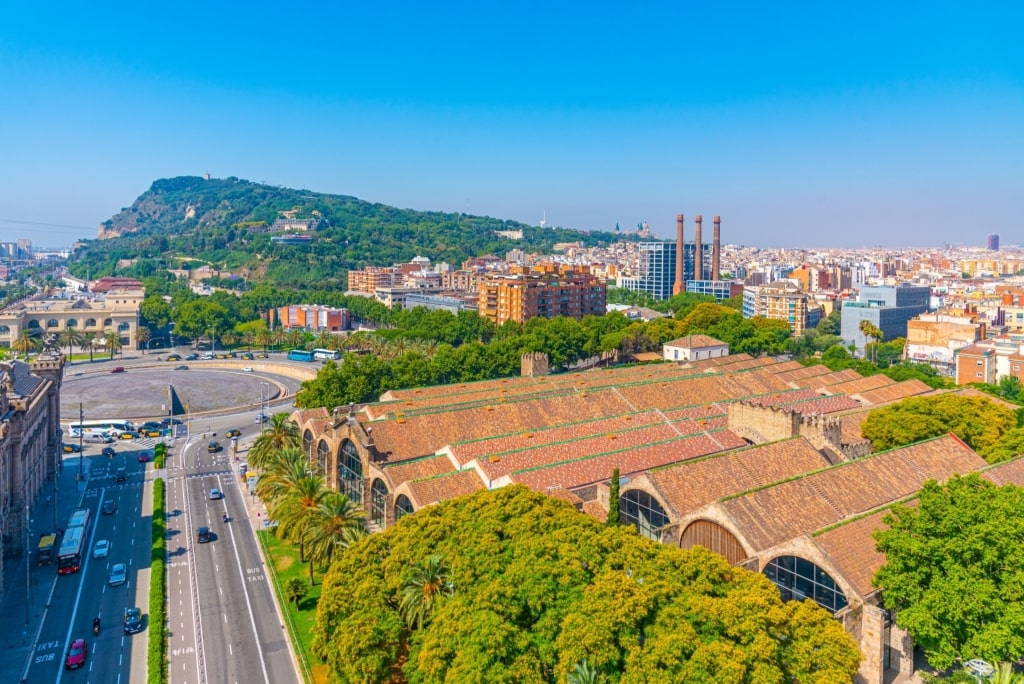
Barcelona Maritime Museum
The captivating Barcelona Maritime Museum is a must-visit. Located within the Drassanes Reials de Barcelona building, the royal arsenal of Barcelona, this seafront museum explores ship-building in the Mediterranean between the 13th and 18th centuries.
For sweet-toothed travelers, the Chocolate Museum, housed in the Convent of Sant Agustí Vell, offers a delightful dopamine hit. Exhibitions on when and how chocolate first arrived in Europe, guided tours, chocolate art, chocolate masterclasses, and tastings are offered.
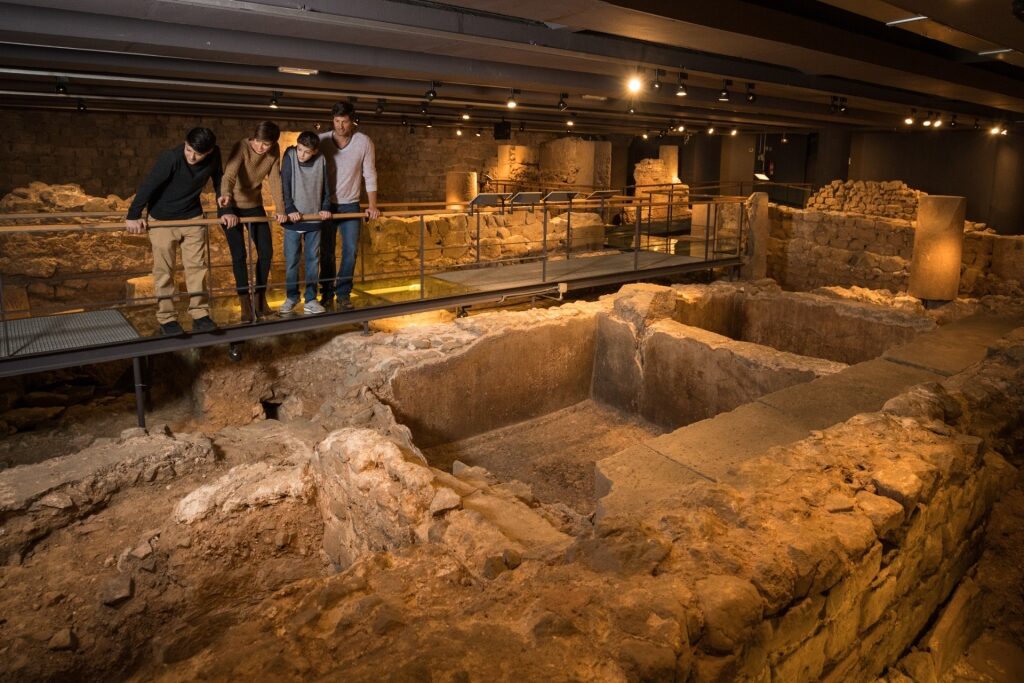
Museu d’Història de la Ciutat
There’s more. The Museu d’Història de la Ciutat on Plaça Reial shines a lens on Barcelona’s Roman past and the Museum of Modern Art on Plaça dels Àngels celebrates works from the second half of the 20th century to the present day. Barcelona’s Centre of Contemporary Culture has a program of exhibitions, festivals, concerts, and films in the Raval district.
Soccer
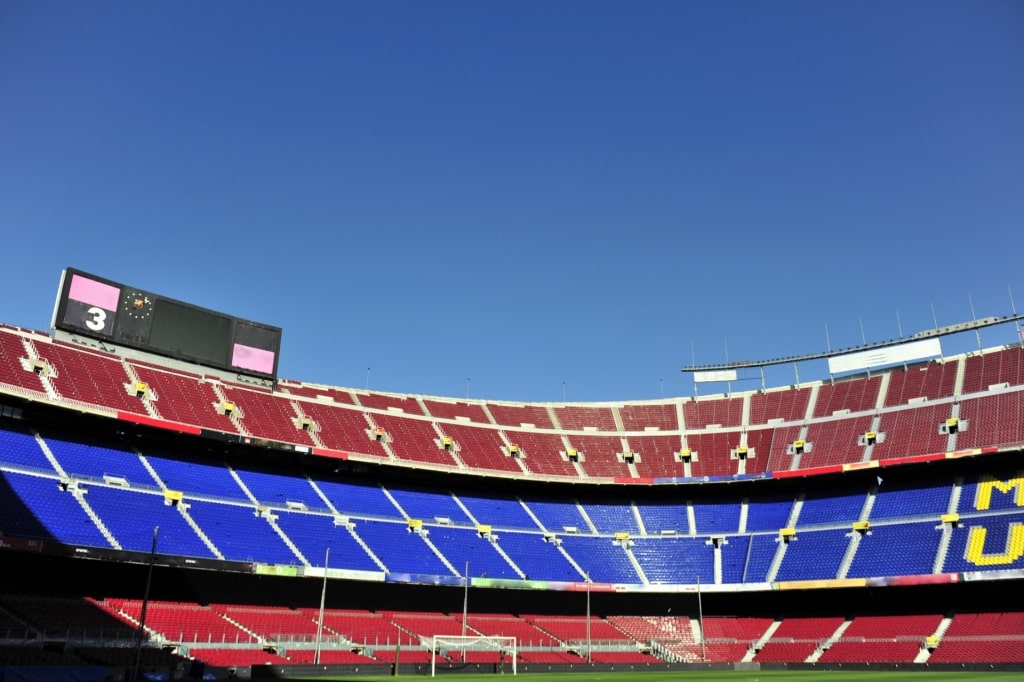
Camp Nou
Soccer—or football in Europe—is a serious matter in Spain. In the Catalan capital, impassioned fans look to F.C. Barcelona, or simply Barça, to get their soccer fix. You’ll only need to stroll along Las Ramblas to spot the club’s emblem flying on flags, baseball caps, and soccer jerseys hanging from storefronts.
To indulge in Barcelona’s soccer culture, a pilgrimage to Barça’s stadium, Camp Nou, is a must. Camp Nou is currently under renovation, with the club playing at the Olympic ground until 2026, but is set to become the largest-capacity stadium in Europe once renovations are complete.
Camp Nou’s museum remains open, offering an insight into one of the world’s most successful soccer clubs, with films, player profiles, trophies, and memorabilia on display. And if you don’t make it to the stadium, you could always watch a game at a buzzy Barcelona bar, with La Liga, the Spanish national league, playing on weekends and some weekdays from August to May.
The Gothic Quarter
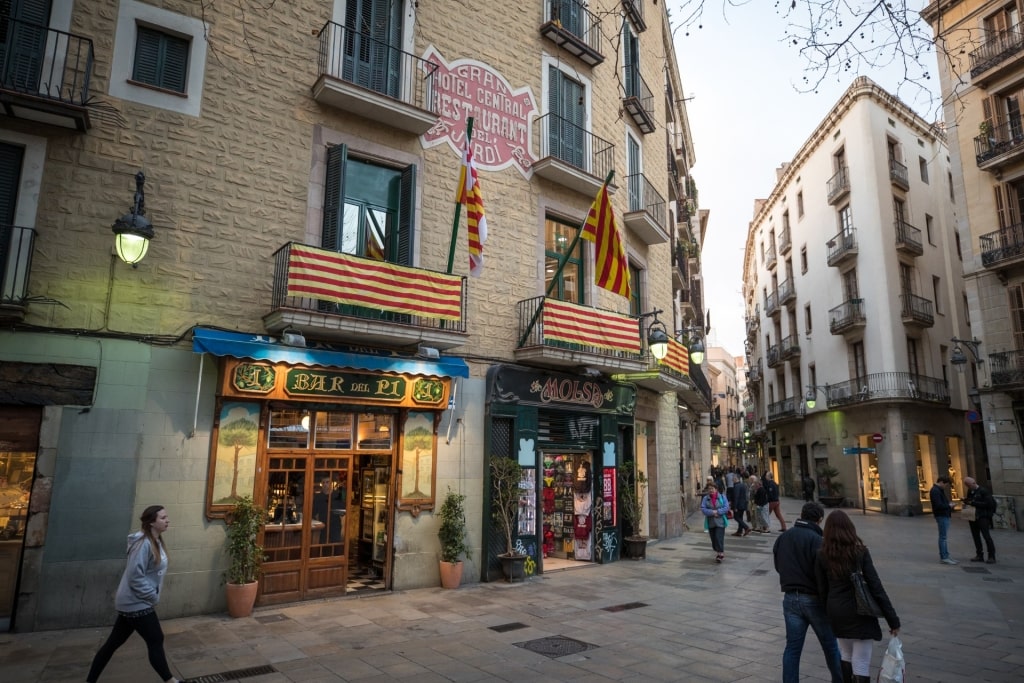
Gothic Quarter
Few old city centers are as charismatic as Barcelona’s Gothic Quarter. With its narrow medieval streets, pretty balconied houses, and Roman ruins, this labyrinthine neighborhood is also packed with grand palaces, Gothic churches, and winding lanes lined with restaurants and bars.
Marvel at the 15th-century City Hall and the Palau de la Generalitat—the seat of the Catalan government—with its elegant Renaissance facade in Plaça de Sant Jaume, just next to the old Jewish Quarter.

El Pont del Bisbe
The building’s original entrance was on Carrer del Bisbe, where you’ll find the show-stopping El Pont del Bisbe. This arched Neo-gothic marble bridge looms over the cobbled street that leads to Barcelona’s dashing cathedral.
Rivaling the Sagrada Familia with its breathtaking spires, gargoyles, and stained-glass windows, Barcelona’s Cathedral was completed in the 14th century, with additions made in later centuries, including the neo-gothic facade in the 19th century.
Some of the best shopping in Barcelona is in the Gothic Quarter, too, with pottery, gourmet produce, fashion apparel, vintage, and homeware stores.
After church-hopping, palace-spotting, and a touch of shopping, soak it all in Plaça Reial, a wide-open square lined with palm trees and al fresco bars and restaurants.
Montjuïc Hill
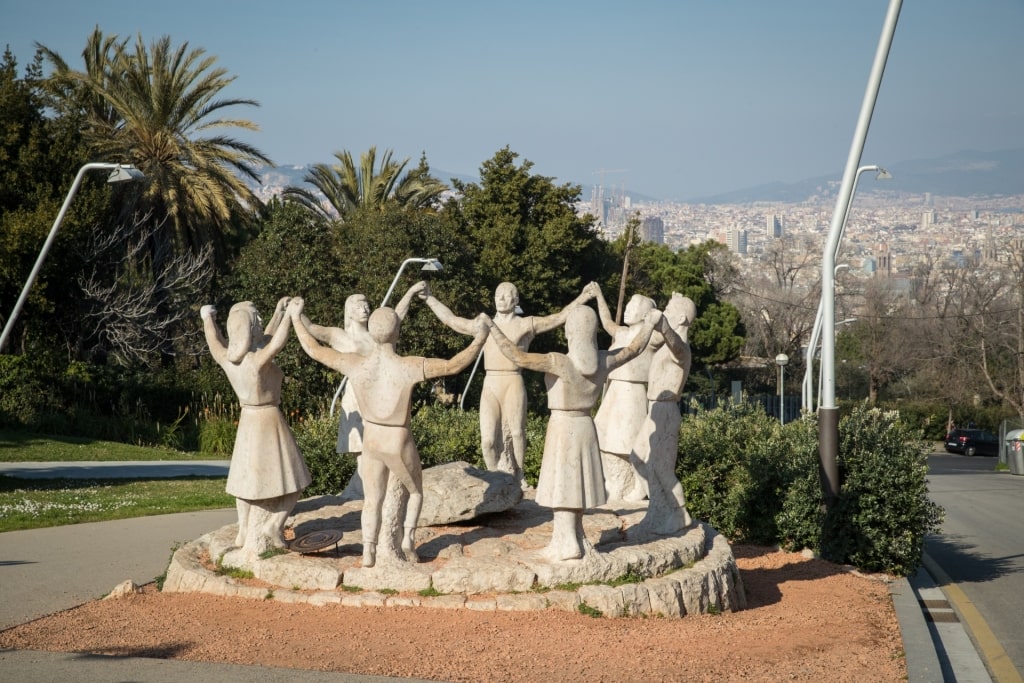
Montjuïc Hill
Montjuïc Hill is a lofty lookout point, rising about 568 feet above the sea, and offers some of the best views in Barcelona. It is the location of the 17th-century military fortress Montjuïc Castle and the Olympic stadium that hosted the 1992 Olympic games.
Many of Montjuïc’s newer buildings and infrastructure were constructed for the 1929 Barcelona International Exposition, including the magnificent Magic Fountain of Montjuïc on Avinguda Maria Cristina.
The early 20th-century Palauet Albéniz, also built for the exposition, is the Catalan residence of the Spanish royal family, used when visiting Barcelona. While the palace is not typically open to the public, the beautiful Joan Maragall Gardens that surround it are. There’s an amphitheater, decorative fountains, ponds, and sculptures dotted around the gardens.
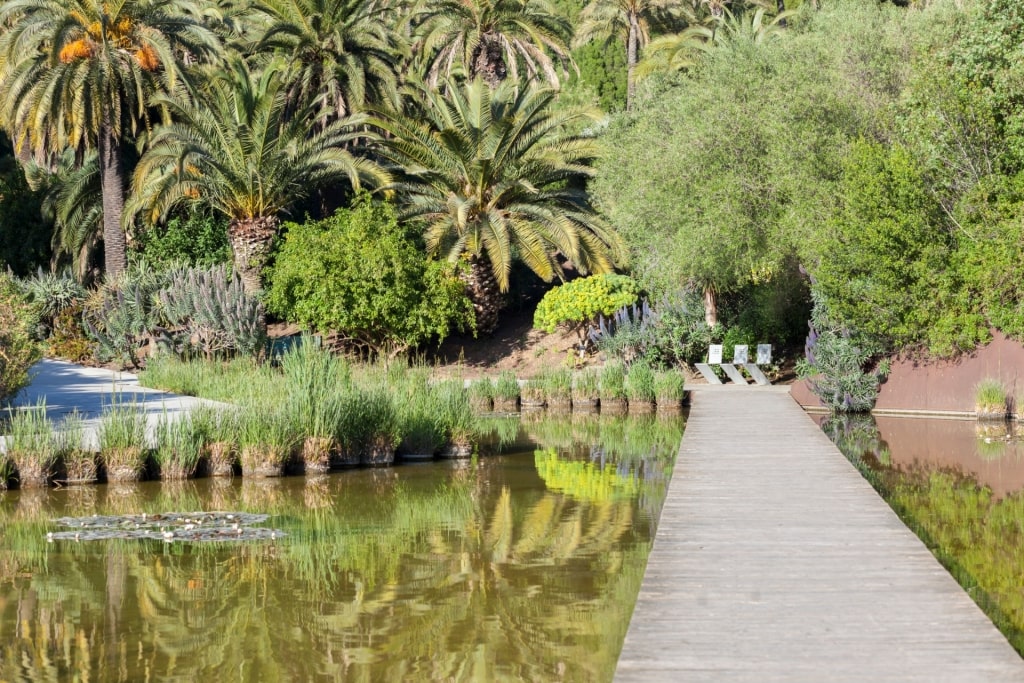
Botanical Garden of Barcelona
Green-fingered travelers are also lured to the tranquil Botanical Garden of Barcelona on Montjuïc Hill. The luscious estate is divided into five sections, the Mediterranean Basin, North Africa, California, Chile, South Africa, and Australia.
As well as a selection of Barcelona’s best museums—Museu Nacional d’Art de Catalunya, Fundació Joan Miró, and the Catalan Museum of Archaeology—Montjuïc Hill also boasts the Poble Espanyol.
Poble Espanyol is an enchanting full-scale recreated Spanish town, with streets, squares, and 117 full-size buildings representing different regions of the Iberian Peninsula, with a theater, restaurants, craft workshops, and a museum.
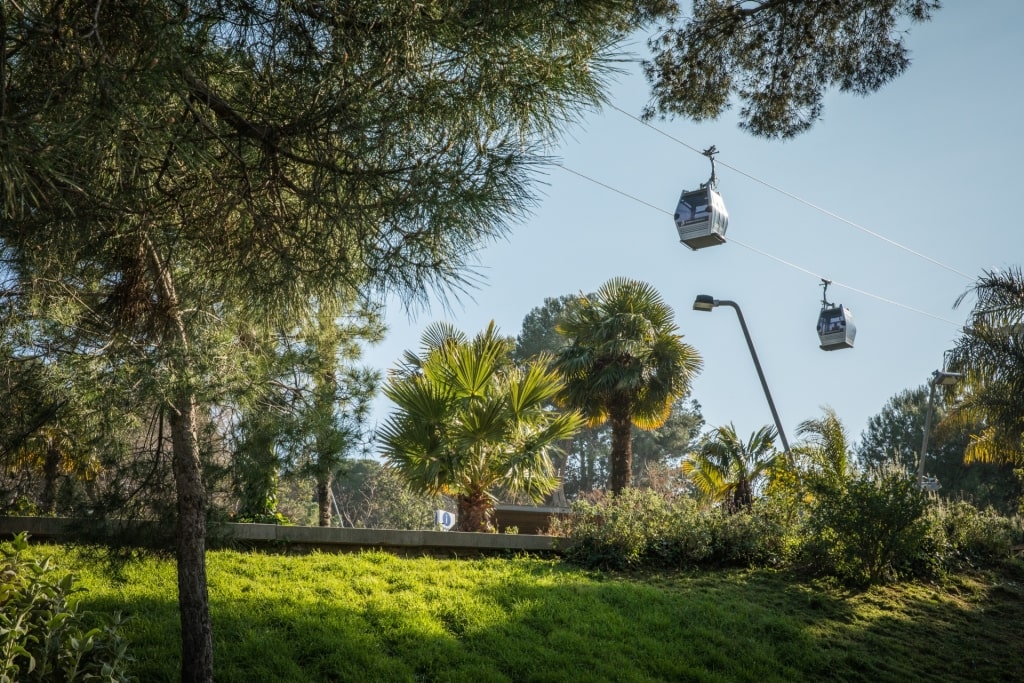
Montjuïc Cable Car
To reach Montjuïc Hil, take the Montjuïc Cable Car or Port Vell Aerial Tramway from one of the lower terminus points near the waterfront.
Read: 3 Days in Barcelona
Gastronomy

Tapas tasting
This sultry Spanish city is famed for its rich culinary heritage, with tasty tapas, multi-course fine dining, and regional specialties such as mouth-watering Catalan tomato bread, also known as pa amb tomàquet.
Delve into Barcelona’s gastronomy on a tapas tasting tour of Catalan restaurants such as the award-winning Glaciar in Plaça Reial, La Taverna del Coure on Carrer de l’Argenteria, and Xup Xup facing Barceloneta Beach.
For a multisensory dining experience, make a reservation at Disfrutar in Eixample. Headed up by three former elBulli chefs, Eduard Xatruch, Oriol Castro, and Mateu Casañas, Disfrutar’s imaginative dishes are works of art and have garnered worldwide attention.
If you’re in the mood for a more casual, lesser-known foodie haunt, try Mercat del Ninot, a food market opposite Disfrutar. Ninot offers 48 food stalls, including Charcuterie Alonso Andrés, a fourth-generation butcher serving delicate slivers of Iberian ham.
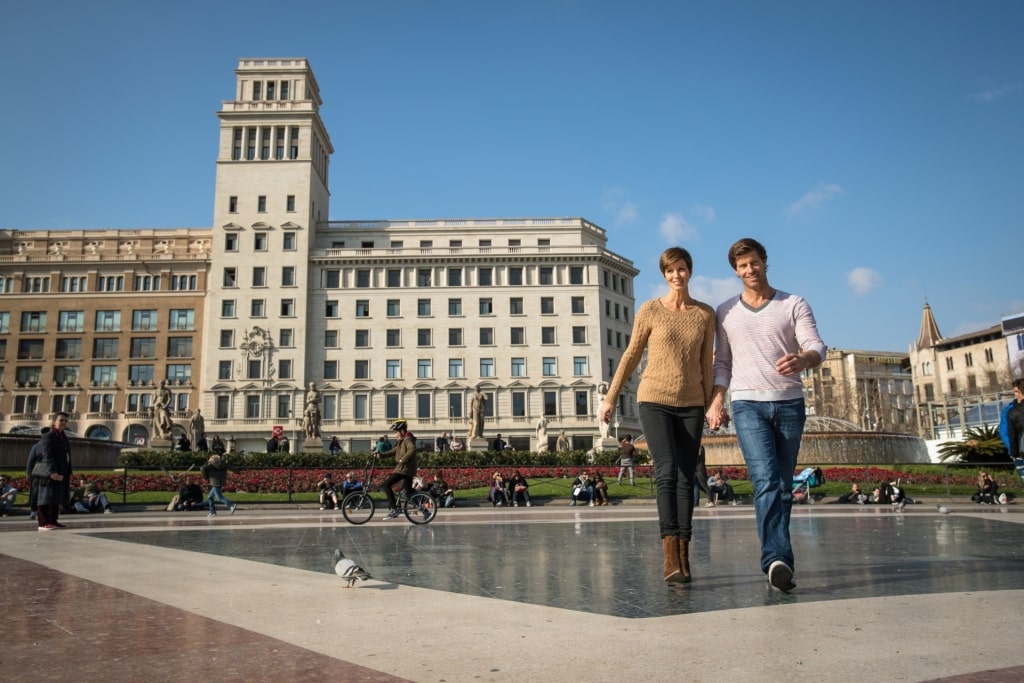
Plaça de Catalunya
Discover for yourself what Barcelona is known for. Browse our cruises to Barcelona and plan your next unforgettable getaway today.


